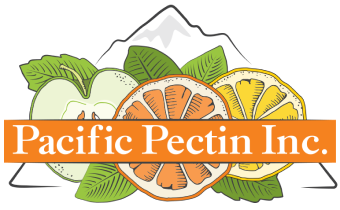Your Pectin Partner Since 1986
Pectin technical information
This page will inform the average pectin user on the technical function of pectins in different environments as it pertains to jam and jelly production. The first part will address High Methoxyl (HM) pectins, and the second part will explain Low Methoxyl (LM) pectins. Lastly, we will offer some tips, tools, and additional products to help you fine tune your product.
PART ONE: High Methoxyl (HM) pectins
HM pectin is the most commonly used pectin, and it breaks into two main categories: Rapid Set and Slow Set. Rapid and Slow Set pectins both react the same way in most situations; however, what separates them from each other is set time and set temperature. Rapid Set pectin will set faster and set at a higher temperature than Slow Set. Because of this, a user would choose Rapid Set pectin for any jams and jellies requiring suspension of matter (such as fruit, peppers, etc.). Slow Set pectin would be chosen for jellies that don’t require suspension. You could use Rapid Set for both situations, but could only use Slow Set for jellies without suspended matter. Our Pacific Pectin Mix for standard sugar jams and jellies is HM pectin.
Parameters for HM pectins
Brix and pH are the two parameters to ensure proper gel strength in your jam, jelly, or preserve.
Brix is the measurement of soluble solids in a liquid. The brix scale is 1 through 100. A soluble solid is any ingredient that goes into solution and maintains its structure. Example: If you put sugar into boiling water it will clarify and you will no longer be able to see it with the naked eye. If you continue to boil the water, eventually you will see the sugar crystals start to form again as evaporation removes the water. So sugar is a soluble solid as well as pectin, acid, and natural sugars in fruit and juices.
The brix parameter for HM pectins is 59% to 66% of your total batch weight as soluble solids (59 to 66 brix), with 65% producing the optimum gel strength. Additionally, The US Food and Drug Administration (FDA) defines a jam, jelly, marmalade or preserve as containing 65% Soluble Solids (65 Brix).
PH is the measurement of the acid content. The pH scale is 0 to 14; 0 being acidic, and 14 being basic. The pH parameter for HM pectins is between 2.9 and 3.3, with 3.2 being optimum.
Recipe Building
When calculating new recipes with HM pectins, the proportions are 53% sugar, 2% pectin, and 45% fruit or juice. These proportions are based on batch weight. The idea is to give you a starting point (before cooking) of around 59 brix which would then evaporate (during cooking) to an end result of around 65 brix (65% of total batch weight is soluble solids). For most fruits, the pH should be in the 2.9 to 3.3 range when 2% Pacific Pectin Mix is used; however, if the fruit or juice being used is particularly acidic or basic to begin with, it will change your final pH.
Pectin Hydration
Fully hydrating HM pectins is necessary to ensure proper gel strength. Pectin is hydrated when it is fully dissolved into a liquid. In order to fully hydrate the pectin, it must be added to a solution that is less than 25 brix. If you attempt to hydrate the pectin in solutions greater than 25 brix, the pectin may partially hydrate, lose gel strength, or possibly not set at all. Therefore, always add your pectin to the boiling fruit mixture before the addition of sugar. It is also a good practice to add the sugar in two parts so the overall temperature does not drop too low, which could cause presetting.
Chemical Reactions
This section should give you a better understanding of how both brix and pH chemically affect the pectin’s ability to set.
Brix Reaction:
As the brix reaches a level of 59 or more, the pectin is now in an environment where the lowered moisture content starts pulling the pectin out of the solution. This causes the pectin to hold onto the solution, or ‘set.’ You do not see the pectin particles because the pectin is still hydrated.
pH Reaction:
When there is sufficient acid in the solution, the acid reacts with the pectin to create a web effect of molecules. This web effect holds the solution together for proper gel strength. Therefore, if there is not enough acid, then there won’t be enough ‘webs’ of molecules to hold the solution together, which will result in a soft-set or no-set product. Too much acid makes the web effect happen too fast, which causes a pre-set or a brittle-set, making the jelly crack and weep water. The acid in the solution is the trigger that begins the setting process.
The amount of acid in the solution directly determines the temperature at which the solution will set. A more acidic solution needs a higher temperature to set, and a less acidic solution needs a lower temperature to set. The set temperature will also directly affect the set time; the lower the temperature, the faster the solution will set. So, the acidity, temperature, and set time go hand in hand.
In conclusion of chemical reactions, it is a combination of both brix and pH maintained in the correct parameters that cause the pectin to set properly.
Four Rules
Use these four rules with HM pectins to ensure good gel strength:
1. Use the correct amount of pectin (minimum 2% batch weight Pacific Pectin Mix).
2. Hydrate the pectin in a solution no greater than 25 brix.
3. Ensure the solution is in between 59 to 66 brix.
4. Ensure the pH of the solution is between 2.9 and 3.3.
PART TWO: Low Methoxyl (LM) pectins
LM pectins differ from HM pectins in that LM pectins only require the presence of a metallic ion (calcium is most commonly used) to cause the reaction that sets the pectin. Hence, the brix and pH levels are not as important. For example, you can gel water with 5% of our LM-O or LM-3 pectin.
LM-3 Pectin: Our LM-3 pectin is designed for use in low-sugar applications ranging from 45 to 55 brix. This gives you a general starting point of 55% fruit 42% sugar 3% LM-3 pectin for most recipes. This would be classified as a 1/3 less sugar product. Your pH range would be 2.9 to 3.5 and determined mostly by taste. The amount of LM-3 to use would be a minimum of 3% of your total batch weight. 1/3 cup LM-3 equals one box (2oz) of store-bought low-sugar pectin, and it can be used interchangeably with recipes using the store-bought version.
LM-O Pectin: Our LM-O pectin is designed for use in products with an end brix of less than 45. This would include products for diabetic and low-carb applications. For most recipes, a general starting point of 95%fruit/concentrated sweetener and 5% LM-O pectin would work. LM-O pectin incorporates preservatives to inhibit mold and bacteria growth once the product is opened and in the refrigerator. The preservatives are necessary to make up for the low amount of sugar, which is a natural preservative. The pH range will be the same as stated for LM-3. The amount of LM-O to use would be a minimum of 5% of your total batch weight.
Pectin Hydration
Hydrating LM pectins will follow the same rules as previously stated for HM pectins.
Factors to Consider
Human Error: As with all areas of life we must consider the aspect of human error in jam and jelly production. The more consistent you are, the more consistent your end product will be.
Consistency of Ingredients: The consistency of the ingredients will play a very big part in the overall quality of your product. If you decide to change suppliers or brands for your ingredients, make sure you get as much info about the new product and compare it to what you were using, and then make the necessary changes when needed.
Consistency of Tools: It is important to use the same kitchen tools for each batch to remain consistent. For example, when using dry measuring cups, make sure that if you buy new cups, they do in fact hold the same amount. This is where a scale becomes important to ensure accurate amounts. Do not assume that a dry measuring cup holds the exact same amount as a different dry measuring cup. Confirm everything. Think of your kitchen as a science lab.
Consistency in the Kitchen: When you are in the kitchen, make sure to stay focused on your task throughout the entire process. Always add your ingredients in the same order, at the same times, using the same equipment. Whether considering your cooking time, temperature, or brix, always use the same method. This way, if your batch doesn’t turn out right, it will be much easier to narrow the problem and find the solution. Consistency is your best asset in the kitchen.
Additional Products
This is a list of additional products we carry to help you fine-tune your product:
FG10 Dow Food Grade Antifoam: Our antifoam is very effective in cutting foam and it will not cause rancidity like oils or butter. Our double strength antifoam is the best value. Instructions are on the bottle for how much to use as a starting point.
Citric Acid: Citric acid is a cost-effective way to replace lemon juice and lower your pH. A 50/50 solution of citric acid and water is 9 times stronger than lemon juice. Determine the amount of lemon juice you need and divide by 9 to achieve the correct amount of citric acid/water solution.
Sodium Citrate: Sodium citrate is used to buffer or raise the pH. This is used in products that have too much natural acid: wild berries, lemon jellies, tart marmalades, pepper jellies etc. A safe starting point would be ¼ of 1% of batch weight.
Pacific Fruit Freshener: Our fruit freshener is designed to be used in products where fruit discoloration, or darkening of the fruit, is a problem. This product contains citric acid and ascorbic acid to retain color.
Tips and Tools
If you are using larger cooking apparatuses such as kettles, these tips and tools will help save you time and money in lost product.
- Monitor your fill time. The shorter the fill time the better. Try never to exceed a fill time longer than 30 minutes. Long fill times in an open kettle system will give you less control of your brix due to evaporation as well as possible damage to the pectin.
- Use a refractometer to accurately determine the brix.
- Use a pH meter to accurately determine the acid content.




